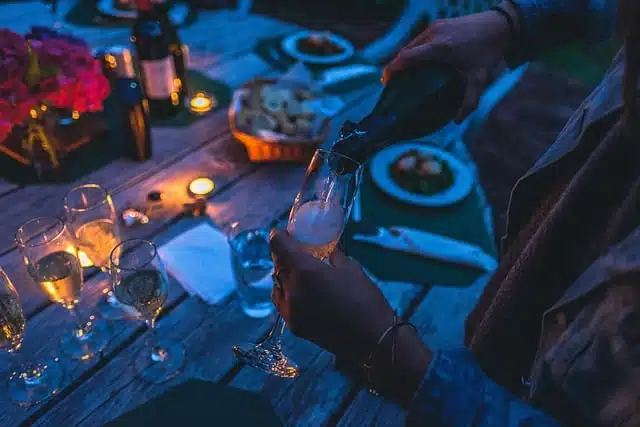Bubbl. preserves popular champagne bottles perfectly
Bubbl. represents a game-changing innovation for restaurant owners and champagne enthusiasts alike, making it effortless to serve premium champagne brands by the glass while preserving their exquisite quality.
This breakthrough system ensures an open bottle of champagne , Cava , or Franciacorta stays fresh for up to seven days without losing its signature sparkling essence. Using a reusable Smart Cap and a quick burst of inert gas (CO₂/N₂), Bubbl. locks in the bubbles , prevents oxidation, and maintains the wine’s aromatic profile and effervescence. Discover how to keep your champagne perfectly preserved .
Expert champagne preservation system: Bubbl.
Traditionally, an open champagnebottle would spoil within hours as oxygen crept in and carbonation faded, limiting the practicality of serving by the glass . Bubbl. solves this problem with professional-grade preservation technology.
A specialized blend of 80% CO₂ and 20% N₂ creates a protective barrier, stopping oxidation in its tracks and keeping those precious bubbles intact. The Smart Cap provides an ultra-secure, reusable seal that equalizes pressure after each pour. The process is simple—pour your glass , twist on the cap, and inject gas for just five seconds—integrating seamlessly into any service workflow.
Bollinger heritage meets modern preservation technology
Bubbl. is powered by Wikeeps system technology, a patented method trusted since 2012 by sommeliers and wine professionals worldwide. Prestigious houses like Bollinger rely on this proven solution to maintain the integrity of their finest cuvées .
By minimizing waste, Bubbl. makes champagne -by-the- glass programs more sustainable and profitable. Its cost-efficient design—inexpensive cartridges and minimal storage needs—pays for itself quickly through increased sales of premium pours.
With Bubbl. , restaurants can now expand their offerings, allowing guests to explore a wider selection—from brut to blanc de blancs , rosé , and rare vintage spécial cuvée —without worrying about spoilage. Waste decreases, while opportunities for discovery multiply.
Just as it transformed wine service years ago, Bubbl. empowers professionals to showcase every nuance of a winemaker’s craft, whether in a tasting flight or a celebratory toast, delivering the full complexity, terroir, and style that define the world’s finest sparkling wines.

Popular Champagne Brands: Expert Guide
Understanding Champagne bottle sizes can transform your tasting journey. A magnum, equivalent to two standard bottles at 1.5 litres, is prized by connoisseurs for its aging potential. The larger volume allows the wine to mature more gracefully, developing richer flavours and perfect balance over time.
French Champagne houses dominate the global market, with iconic names like Moët & Chandon, Veuve Clicquot, Bollinger, Louis Roederer, and Taittinger leading the way. According to Drinks International’s “World’s Most Admired Champagne Brands 2025”, Louis Roederer claims the top spot, followed closely by Krug and Bollinger – all celebrated for their exceptional quality across both vintage and non-vintage cuvées.
Among the most beloved styles are NV Brut (the signature offering from most houses with crisp, biscuit notes), Blanc de Blancs (made exclusively from Chardonnay), and vibrant Rosé Champagnes bursting with berry flavours. Each style presents a unique taste profile that pairs beautifully with different occasions and cuisine.
Choose your Champagne to suit the moment: reliable NV Brut works perfectly for casual gatherings, while special celebrations call for prestigious vintage selections like Dom Pérignon or Krug. For tasting events, preservation systems like Bubbl help maintain the sparkling wine’s freshness for several days after opening.
Champagne Bottle Sizes and Réserve Selections
Champagne is available in an impressive range of sizes, from the modest Demi to the monumental Melchizedek. Knowing these formats helps you select the perfect bottle for any occasion and understand how size affects the wine’s aging process and flavour development.
- Demi or Half: At 375ml, it’s ideal for personal tastings or intimate moments.
- Standard Bottle: The 750ml format you’ll find most commonly in stores and restaurants.
- Magnum: 1.5 litres (two bottles) – perfect for sharing and provides superior aging potential.
- Jeroboam: 3 litres (four bottles) – a favourite for festive celebrations.
- Rehoboam: 4.5 litres (six bottles) – often featured at corporate events.
- Methuselah: 6 litres (eight bottles) – makes a stunning centrepiece.
- Salmanazar: 9 litres (twelve bottles) – designed for grand celebrations.
- Balthazar: 12 litres (sixteen bottles) – coveted by serious collectors.
- Nebuchadnezzar: 15 litres (twenty bottles) – represents the height of luxury.
- Melchizedek or Midas: 30 litres (forty bottles) – the ultimate Champagne showstopper.
These distinctive names are reserved exclusively for sparkling wines, with bottles beyond Nebuchadnezzar size typically reserved for truly exceptional events. Experts agree that Champagne develops more complexity and refined taste when aged in magnum and larger formats – a fact that discerning collectors particularly appreciate.
Champagne price guide: brut, blanc, and rosé vintage options
Champagne prices can vary significantly based on factors like style , champagne brands , vintage , and bottle size. Whether you’re buying for personal enjoyment or professional service, understanding these elements will help you make the best choice.
- Entry-level brut champagne: For €30-50, you can find excellent non-vintage brut options from top houses. These dry champagnes have minimal sugar, offering a crisp taste that works well with all kinds of food.
- Mid-range blanc de blancs: Made exclusively from Chardonnay grapes, these refined champagnes (€50-100) showcase beautiful minerality and citrus notes – perfect with seafood.
- Premium brut selections: Iconic champagne brands like Dom Pérignon range from €100-500+. You’re paying for superior vineyard sources, extended lees aging, and expert blending skills.
- Luxury vintage cuvées: Collector’s items – including rare vintages or magnum bottles – can cost thousands, representing the absolute pinnacle of champagne craftsmanship and aging potential.
From affordable to ultra-luxury, these price tiers reflect each producer’s standing and quality. Remember: only wines from Champagne’s AOC region can carry the name. Other regions produce outstanding sparkling wines that deliver similar great champagne character at friendlier prices.
Expert tasting notes for popular champagne styles
Moët & Chandon remains one of the world’s most instantly recognizable champagne brands. Hailing from Épernay, this house is celebrated for both consistency and innovation. Their Brut Impérial delivers perfect balance between fruity and toasty notes in every glass .
Champagne preferences differ across markets and palates. Other exceptional producers – including Veuve Clicquot , Bollinger , and Taittinger – all offer distinct house style and unique tasting notes worth exploring.
At the luxury end, Dom Pérignon and Louis Roederer Cristal are revered by expert collectors. These wines undergo extended lees contact, developing remarkable complexity with layers of fruit, toast, and cru character.
The magic trio of grapes – Chardonnay, Pinot Noir , and Meunier – each contributes special qualities to the final blend . Chardonnay provides elegance, Pinot Noir gives structure, while Meunier offers immediate fruit-forward appeal.
Quality differences exist even within a single producer’s range – whether it’s their brut , rosé , blanc de blancs, vintage selections, or specialty cuvées . Professional tasting helps identify these nuances, ensuring you select the perfect bottle for any occasion. When serving by the glass , proper techniques preserve the wine’s bubbles, aromas, and dry flavor profile exactly as intended.
